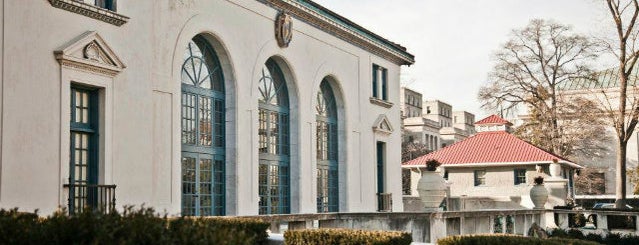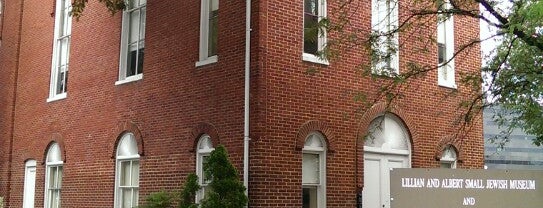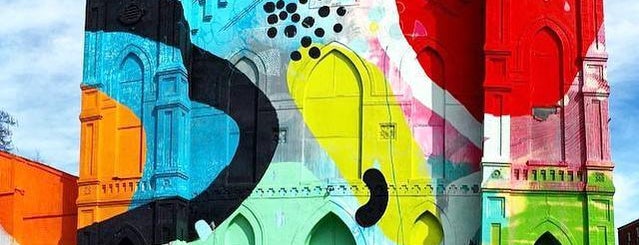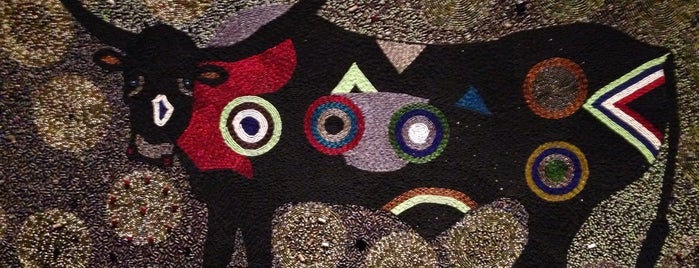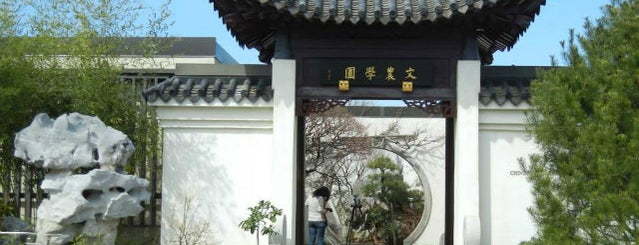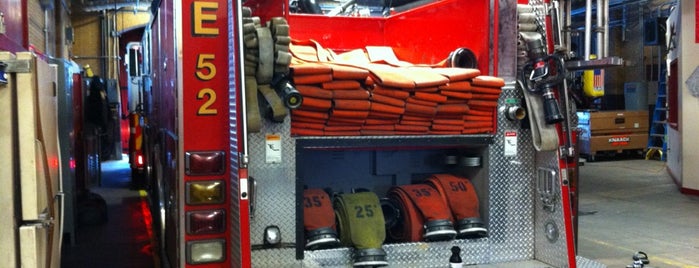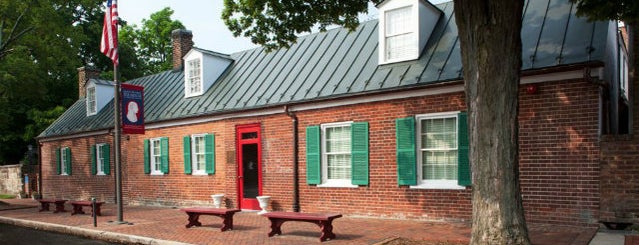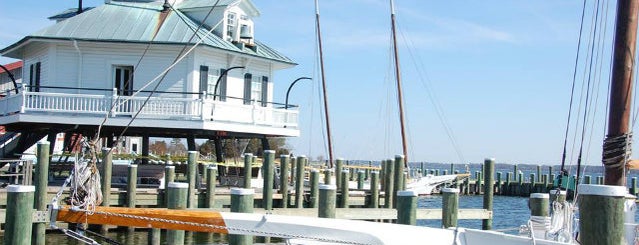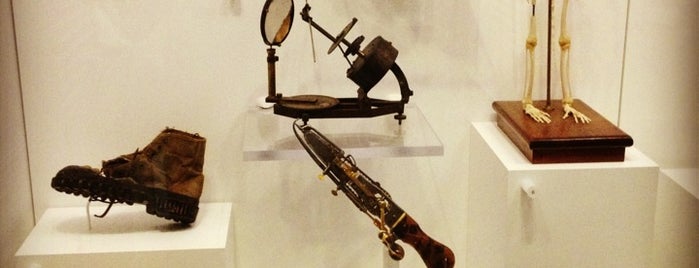![]() All told, a permanent gathering of about 2,000 paintings, sculptures, installation pieces, prints, drawings and photographs are on display. Read more.
All told, a permanent gathering of about 2,000 paintings, sculptures, installation pieces, prints, drawings and photographs are on display. Read more.
![]() Today, the Adas Israel congregation is the oldest synagogue structure in Washington and hosts a treasure trove of Jewish historical items specific to the Washington, D.C. area. Read more.
Today, the Adas Israel congregation is the oldest synagogue structure in Washington and hosts a treasure trove of Jewish historical items specific to the Washington, D.C. area. Read more.
![]() Until earlier this year known as the Sewall-Belmont House and Museum, this Capitol Hill mansion has served as a seat of the women’s suffrage and equal rights movements since 1929. Read more.
Until earlier this year known as the Sewall-Belmont House and Museum, this Capitol Hill mansion has served as a seat of the women’s suffrage and equal rights movements since 1929. Read more.
![]() It’s an old Baptist church the congregation abandoned for two decades after moving to new digs. A group of artists found the building and covered it in a vibrant mural. Read more.
It’s an old Baptist church the congregation abandoned for two decades after moving to new digs. A group of artists found the building and covered it in a vibrant mural. Read more.
![]() This museum is dedicated to rugs, flags, and other pieces of textile art. The museum’s regular collection includes rugs dating back to 3,000 BCE and specializes in pieces from Asia. Read more.
This museum is dedicated to rugs, flags, and other pieces of textile art. The museum’s regular collection includes rugs dating back to 3,000 BCE and specializes in pieces from Asia. Read more.
![]() Likely the most overlooked of the Smithsonian Institutions, it is also one of the closest things we have to a museum of D.C. history—with a particular emphasis on the neighborhood where it sits. Read more.
Likely the most overlooked of the Smithsonian Institutions, it is also one of the closest things we have to a museum of D.C. history—with a particular emphasis on the neighborhood where it sits. Read more.
![]() Yeah, this is exactly what you think it is: a big museum full of 150 of the sickest freaking bonsai trees you will ever see. Ensconced in pagodas, water features, and beautiful Chinese architecture. Read more.
Yeah, this is exactly what you think it is: a big museum full of 150 of the sickest freaking bonsai trees you will ever see. Ensconced in pagodas, water features, and beautiful Chinese architecture. Read more.
![]() Most people know the short history of Clara Barton: The Civil War nurse who founded the Red Cross. This museum is the office where Barton and a few others helped an estimated 22,000 families reunite. Read more.
Most people know the short history of Clara Barton: The Civil War nurse who founded the Red Cross. This museum is the office where Barton and a few others helped an estimated 22,000 families reunite. Read more.
![]() Housed on one floor of a working fire station, there are artifacts from helmets to old-fashioned fire trampolines (or whatever they’re really called). Some of them date back to the 18th century. Read more.
Housed on one floor of a working fire station, there are artifacts from helmets to old-fashioned fire trampolines (or whatever they’re really called). Some of them date back to the 18th century. Read more.
![]() The Laogai is a brick-and-mortar indictment of China’s long-standing forced labor camps. The museum offers a fascinating, multi-media look at the prison camps that allegedly still operate there today. Read more.
The Laogai is a brick-and-mortar indictment of China’s long-standing forced labor camps. The museum offers a fascinating, multi-media look at the prison camps that allegedly still operate there today. Read more.
![]() An Earth Lab, a Life Lab, and an Idea Lab comprise this STEM haven. Interactive games and experiments are the focal point here, with a liberal dose of current events and state-of-the-art tech. Read more.
An Earth Lab, a Life Lab, and an Idea Lab comprise this STEM haven. Interactive games and experiments are the focal point here, with a liberal dose of current events and state-of-the-art tech. Read more.
![]() The Treaty of Ghent, which formally ended the War of 1812, was signed within its walls. A small museum inside the mansion preserves original artifacts. Read more.
The Treaty of Ghent, which formally ended the War of 1812, was signed within its walls. A small museum inside the mansion preserves original artifacts. Read more.
![]() Did you know Monroe was a soldier in the American Revolution and was almost killed in the famous Battle of Trenton? And of course that’s to say nothing of the Monroe Doctrine. Read more.
Did you know Monroe was a soldier in the American Revolution and was almost killed in the famous Battle of Trenton? And of course that’s to say nothing of the Monroe Doctrine. Read more.
![]() Drug concealment artifacts capture the eye and a detailed photographic history of illegal drugs and the war against them in America provide a rich education. Read more.
Drug concealment artifacts capture the eye and a detailed photographic history of illegal drugs and the war against them in America provide a rich education. Read more.
![]() Martha Washington and Robert E. Lee used to pop in to this drug store, which boasts a massive collection of antique medical equipment and herbal remedies that were used centuries ago. Read more.
Martha Washington and Robert E. Lee used to pop in to this drug store, which boasts a massive collection of antique medical equipment and herbal remedies that were used centuries ago. Read more.
![]() Their website declares it as being “dedicated to preserving and exploring the history, environment and people of the Chesapeake Bay.” They do it with things like a replica crab-processing plant. Read more.
Their website declares it as being “dedicated to preserving and exploring the history, environment and people of the Chesapeake Bay.” They do it with things like a replica crab-processing plant. Read more.
![]() Lay down your bullet-biting stereotypes and learn a little something. Learn about the ways in which the war incubated the modern hospital and plenty of other medical advances we take for granted. Read more.
Lay down your bullet-biting stereotypes and learn a little something. Learn about the ways in which the war incubated the modern hospital and plenty of other medical advances we take for granted. Read more.
![]() This is about as interactive as museums get. Visitors can ride preserved streetcars out into the wooded areas around the museum. Trolleys from as far as Belgium and Germany round out the collection. Read more.
This is about as interactive as museums get. Visitors can ride preserved streetcars out into the wooded areas around the museum. Trolleys from as far as Belgium and Germany round out the collection. Read more.
![]() Wilbur Wright trained the first army pilots right here, across the street from the University of Maryland campus and six blocks or so from R.J. Bentley’s. Read more.
Wilbur Wright trained the first army pilots right here, across the street from the University of Maryland campus and six blocks or so from R.J. Bentley’s. Read more.
![]() Preserved bodies displaying exotic diseases and other conditions do appear in the collections. There’s plenty more to see, like historical artifacts on vaccinations and wartime medicine. Read more.
Preserved bodies displaying exotic diseases and other conditions do appear in the collections. There’s plenty more to see, like historical artifacts on vaccinations and wartime medicine. Read more.

